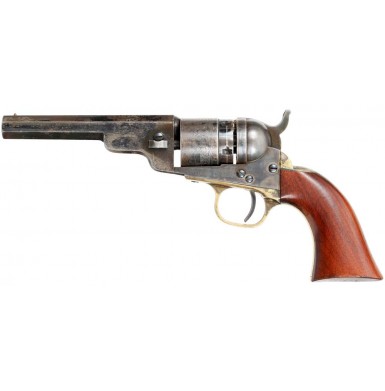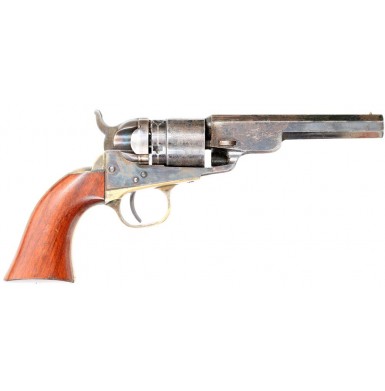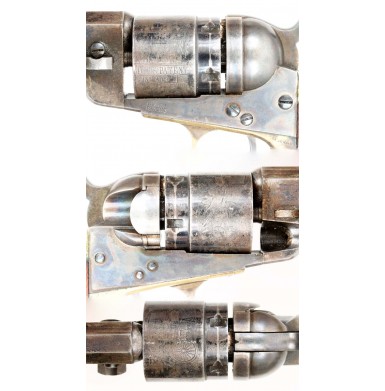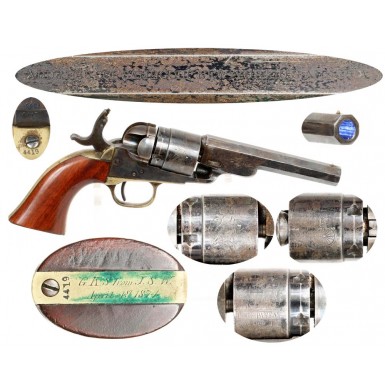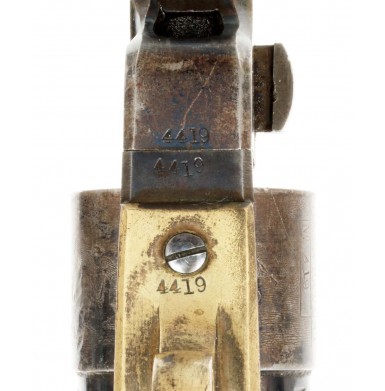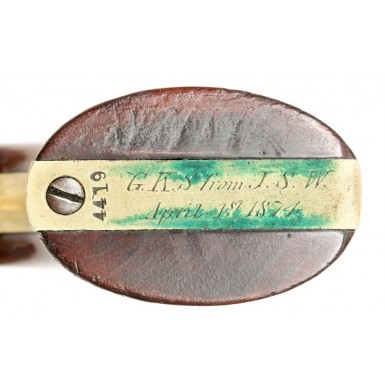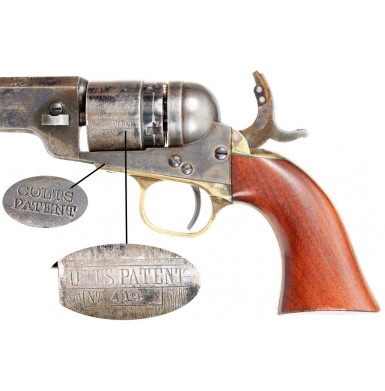Colt Pocket Navy Cartridge Revolver - Very Fine & Inscribed
- Product Code: FHG-1842-SOLD
- Availability: Out Of Stock
-
$1.00
At the close of the American Civil War the Colt Patent Firearms Company was aware of two facts that would greatly impact their business for the next decade. First, the end of war not only meant no more major US military orders for handguns in the foreseeable future, it also meant that thousands of surplus US military percussion revolvers would soon be flooding the civilian market, making newly made percussion revolvers difficult, if not impossible to sell. Second, the day of the percussion revolver was over for all practical purposes, and the new self-contained cartridge handgun was the wave of the future. Unfortunately for the Colt Patent Firearms Company, Smith & Wesson held the exclusive rights to Rollin White’s patent on the bored-through cylinder, which meant that until that patent expired in 1869 there was no easy way for Colt to manufacture a traditional cartridge revolver without infringing upon that patent. Colt also had thousands of parts on hand to produce the many models of percussion handguns that had been its bread and butter business since the firm was founded. Immediately the Colt designers were put to work to find reasonable ways to manufacture cartridge handguns from the parts on hand, as well as to establish systems to convert existing percussion revolvers to cartridge handguns. Although the possibilities for both production and conversion were somewhat limited until the expiration of White’s patent protection, the designs patented by F. Alexander Thuer in 1868 and 1870 allowed Colt to offer Thuer conversions of all their popular percussion models as an interim product line, until bored through cylinders could be used. The Thuer system was not particularly successful and only about 5,000 Thuer altered revolvers of all models were produced. It is interesting to note that the first of the Colt “bored through cylinder” cartridge revolvers to be offered after the expiration of White’s patent were not alterations of existing models, but were two completely new product lines, the .22RF Colt Open Top revolvers and Colt Cloverleaf Pocket Revolvers. Following their introduction Colt started to produce the Richards and Richards Mason conversions of their larger framed revolvers, including the M-1860 Army and the M-1851 and M-1861 Navy models. These were produced both as newly made guns, using percussion revolver parts on hand, as well as true conversions of previously manufactured percussion revolvers. In total about 9,000 M-1860 Army Richards conversions were produced, with an additional 2,100 Richards-Mason Army models manufactured. About 3,800 M-1851 Navy revolvers were altered to .38 caliber (both rimfire and centerfire) and another 2,200 M-1861 Navy revolvers were so altered. The single largest batch of altered, converted or remanufactured revolvers were in the 1862 Police and Pocket Navy sizes, all altered to .38 caliber, in either rimfire or centerfire. Colt produced 24,000 cartridge revolvers on this mid-sized frame between 1873 and 1881, with a wide variety of models (at least 5) and configurations. For the ease of identifying these guns for modern collectors, the guns have essentially been divided into categories based upon their barrel profile (octagon or round), barrel lengths and the presence or absence of an ejector system. In some cases, the guns were made almost completely from left over percussion parts on hand. In other cases, they were alterations of completed percussion guns, and sometimes they were a hybrid of old and newly made parts. To make matters more confusing the presence or absence of features like loading gates and barrel addresses almost appear to be random on some “models”, and to further muddy the waters, these mid-sized .38 cartridge revolvers were produced in 3 different serial number ranges! The guns are found serial numbered in the upper regions of the M-1849 Pocket serial number range (between about 274,000 and 328,000), in the upper regions of the M-1862 Pocket Navy and Police ranges (found between about 36,000 and 48,000) and in their own range of 1-19,000. The guns were manufactured between 1873 and 1880/81 with most of the new serial number range guns manufactured between 1873-1875, and the balance of the guns primarily being produced circa 1875-1880. In all cases, the unsold stock remained on hand and in many cases these altered revolvers were still shipping in the mid-to-late 1880s, sometimes several years after having been assembled.
Offered here is a VERY FINE example of what collectors refer to as the 4 ““ Octagon Barrel Model, aka Pocket Navy Conversion in .38 rimfire. Like all of the other similar .38 cartridge guns that Colt produced during this era, the revolver was based upon the frame of the 1862 Pocket Navy / Police series and uses the 5-shot rebated round cylinder of the 1862 Pocket Navy. The barrels for these guns were 4 ““ long and as the name implies had an octagon profile. The guns were manufactured from about 1873 through 1875, with about 4,000 being produced during that time. Roughly 80% of the production was in .38 rimfire and the remainder was in .38 centerfire (.38 Colt). This is one of the guns made in its own serial number range of about 1-19,000, and are typically newly made cartridge guns that never were percussion, but sometimes have re-used and altered percussion cylinders, as well as previously unused percussion parts like frames, triggerguards, etc. The guns were made without an ejector rod, and rarely did they have a loading gate. With the relatively short barrels, and lack of ejectors, the guns were probably among the first Colt cartridge revolvers that could be termed “sheriff’s models”. This example is numbered in the new production range with the serial number 4419, placing production in 1874, two years before the Custer massacre at the Little Big Horn. The matching serial number 4419 is found on the bottom of the grip, on the front of the triggerguard plate, on the bottom of the frame and on the bottom of barrel web. These same 4 digits are neatly written in ink, in a period hand, in the backstrap cut out of the grip as well. The cylinder is numbered with the last 3 digits of the serial number, 419, and it has not been renumbered to match, as the large majority of these cylinders were after they were re-machined from percussion to cartridge. The most difficult process in the manufacturing of the Colt cartridge revolvers was machining the formerly percussion cylinder into a cartridge cylinder. For that reason, as guns were being altered, from both left over parts and previously manufactured percussion guns, it was not uncommon for a cylinder that had already been machined to be pulled from a parts bin and used, while the cylinder that originally went with the gun was sent to the machine shop to be altered. These factory replacement cylinders were then re-numbered to match the balance of the cartridge revolver. The wedge is an unnumbered, “cartridge wedge” with the machined groove and no spring. These are the types of wedges found on many conversions as well as those percussion parts guns manufactured as cartridge revolvers. This is absolutely correct and its condition matches the gun perfectly, suggesting it is almost certainly original to the revolver. The “conversion” number on the gun is 4306. This number mated the special non-percussion parts from the alteration process. This number appears on the bottom of the cylinder arbor, on the rear of the loading gate and almost certainly inside the conversion ring. However, the conversion ring number can only be seen by removing the arbor (a good way to damage the gun) and then the conversion ring itself. It is interesting to note that the gun has a loading gate, a feature rarely encountered on these alterations and usually an indication of very early production. The rebated cylinder is clearly marked COLT’s PATENT over the serial number and retains about 95%+ of its original “stagecoach hold up” roll engraved scene. The left side of the frame is clearly stamped with the old, original two-line percussion marking: COLT’s / PATENT and not with the more commonly encountered two-line cartridge patent information: - PAT. JULY. 25, 1871 - over - PAT. JULY. 2, 1872 - . This is an indication that the frame was an original percussion frame used to make the cartridge gun, and the lack of the later patent stampings is again an indication of very early production. The left rear of the triggerguard web is stamped with the original percussion caliber marking .36 CAL.. The octagon barrel is marked with the usual, late production one line New York address and reads: ADDRESS COL SAML COLT NEW-YORK U.S. AMERICA. The most interesting marking on the gun is not factory, but is a period engraved inscription on the bottom of the butt that reads in two lines: G.K.S. from J.S.W. / April 1st, 1874. The presentation date certainly aligns with the features of the revolver that suggest early production circa 1874. Who “G.K.S.” and “J.S.W.” were is probably lost to history, but the presentation suggests that “G.K.S.” was undertaking something in the spring of 1874 that “J.S.W.” thought worthy of a firearm, for whatever reason. The initials suggest that the gift was not from father to son or similar close familial tie, and a certain romantic streak makes one want to think this may have been given to “G.K.S.” as he departed for parts unknown in the American West by a dear friend. Maybe further research in the Colt archives can reveal who the two sets of initials refer to.
As previously noted, the revolver is in about VERY FINE+ condition. The frame retains about 90% of its original Colt factory case hardened finish. The finish retains the more brilliant coloration that is typically found on Colt percussion era revolvers, rather than the darker colors of the cartridge era finishing. The case color remains about about 70% vivid, with some toning and dulling, mostly around the edges of the frame where it has developed a brownish patina. Large patches of vibrant purples, blues, and golden yellow-brown tones are clearly evident, mostly in the center of the the frame on both sides. The areas that have faded from their original vivid coloration have dulled to a smoky and mottled gray with some freckled brown tones. The frame is free of any pitting, but does show some scattered small flecks of light surface oxidation, as well as some very lightly scattered pinpricking along the upper edges, right below the cylinder and near the cylinder mouths. The rimfire hammer retains about 35%+ of its vivid case coloring, most of which is centered on the body and spur of the hammer. The balance of the hammer shows significant fading and dulling, leaving a mostly brownish patina mixed with the traces of remaining vivid colors. The cylinder retains about 30%+ of its original blued finish, mostly along the rebated portion of the cylinder and showing the most loss on the large portion where the scene is roll engraved. The balance of the cylinder has a smoky gray patina with some mottled freckles of brownish and darker gray surface oxidation and age discoloration evenly scattered over all of its surfaces. The cylinder scene remains extremely sharp and clear and remains at least 90% present. The brass backstrap, gripstrap and triggerguard retain only some minor traces of their original silver plated finish, but do have a very attractive, deep golden patina that is untouched and uncleaned. The bottom of the brass gripstrap shows a nice layer of dark green verdigris as well. The 4 ““ octagon barrel retains about 40% of its original blued finish which is strongest on the bottom barrel flat and the two angled flats immediately adjoining it. Blue remains on all sides of the octagon barrel as well as the web, but had apparently flaked away, leaving streaky remnants of the original bright blue over most of the barrel and web. The balance of the barrel shows a dark, smoky gray patina with some brown overtones of oxidized discoloration and a distinctive bluish hue from the original finish. The right side of the web shows some very minor impact marks as a result of the wedge being driven out of the revolver many times, and the web area shows some minor surface scratching on both sides from handling and use. The barrel is free of any significant pitting, but does show some very small flecked areas of light pinpricking and some scattered traces of light surface oxidation along its length. The original cone shaped brass front sight post remains in place and is nicely formed with a lovely dark, uncleaned patina. The bore of the revolver is in VERY GOOD+ to NEAR FINE condition and remains mostly bright with very well-defined rifling its entire length. The bore shows some lightly scattered pitting and minor oxidation along its length, with a couple of spots of more significant oxidized roughness as well. The gun is mechanically EXCELLENT and indexes, times, and locks up perfectly, with the hammer responding crisply to the trigger. The screws all appear to be original to the gun and most are in very fine condition. The frame screws remain crisp with no slot wear and all retain at least 40% or more of the vivid nitre blued finish with purple tones. The wedge screw remains crisp as well, but has dulled to a dusky dull blue. The butt screw and both rear frame screws show some minor slot wear and have all dulled to a darker blue-gray color with no vivid blue remaining. The one-piece walnut grip is in about VERY FINE condition, and as previously mentioned is numbered to the gun in the backstrap cut out in period ink. The grip retains the large majority of its original varnish, probably about 85%+. The varnish has thinned and worn slightly, but only shows obvious loss along the the sharp edges at the bottom of the grip where it flares slightly. Even the leading and trailing edges of the grip remain crisp and sharp with no missing chips in these delicate locations. The grip does show some lightly scattered minor scuffs, dings and handling marks that are expected from a 19th century revolver that probably spent at least some time being carried in a pocket.
Overall this really fantastic example of a Colt 4 ““ Octagon Barrel Cartridge Revolver. These little guns were made in a relatively small quantity of about 4,000, during the height of westward expansion immediately after the American Civil War. As they were cheaper than the larger Richards and Richards-Mason guns and could easily be carried in a pocket, most do not survive in very nice states of preservation. This one is a particularly early and scarce example with a lower serial number, original percussion frame markings and a rarely encountered factory loading gate. The lovely period inscription on the bottom of the grip strap only makes the gun more intriguing, and a request for a Colt Factory Letter might shed some light onto who “G.K.S.” and “J.S.W.” were. This would be a fabulous addition to any collection of Colt revolvers or “Old West” arms, and is a really striking example. You will certainly be proud to display this fine revolver and enjoy it in your collection.
SOLDTags: Colt, Pocket, Navy, Cartridge, Revolver, Very, Fine, Inscribed


